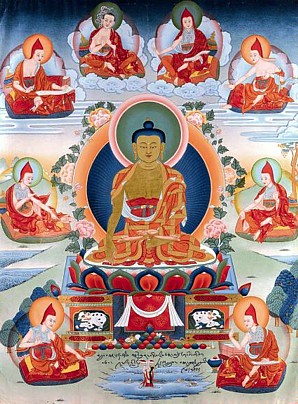Shastra 論

Shastra (Skt. śāstra; Tib. བསྟན་བཅོས་, tenchö; Wyl. bstan bcos) — a treatise or commentary upon the words of the Buddha (Tib. བཀའ་, ka; Wyl. bka’). In Tibet, many of the most important shastras composed by the great Indian masters of the past were compiled into a collection known as the Tengyur, or translated treatises, comprising around 228 volumes (depending on the edition).
Commentary
The Sūtra Requested by Devaputra says:
ལེགས་པར་གསུངས་དང་དེའི་དགོངས་འགྲེལ་བ། །
དེའི་དབང་གིས་ཤཱཀྱའི་བསྟན་པ་ནི། །
All Dharma teachings are included in the Buddha’s word and the treatises,
The excellent speech and the commentaries on its intended meaning,
By means of these, the teaching of the Śakya
Will remain for long within this world.
- Śākyamuni, Sūtra Requested by Devaputra
As this says, all the excellent teachings of the Dharma can be included within two categories: the speech of the victorious Buddha and the treatises which provide commentaries on its intended meaning.
Vasubandhu said:
- That which subdues all the enemies, one’s own afflictions,
- And guards against future existence in the lower realms,
- Is called a ‘treatise’, because it subdues and protects,
- These two features are not found in other traditions.
- --Well Explained Reasoning
Patrul Rinpoche says:
- There are four obstacles which can prevent those with understanding from taking interest in a particular treatise. They are:
- thinking that it is devoid of any purpose,
- thinking that it has a purpose but that one would never be able to accomplish it,
- thinking that although possible it is not something an honourable person would wish to pursue, or
- thinking that even though it is honourable, there are other easier methods or that there is a lack of connection (between the methods and the goal).
- In the present case, if we take each of these in turn, then:
- unlike a treatise on dentistry for crows, for example, generally there is some purpose to it.
- Furthermore that purpose is achievable, so it is not like a treatise on stealing the crown jewel from the naga king.
- Not only that, but the aim, which is achievable, is also a sublime aim for individuals to pursue, so it is not like a treatise on how to marry your mother.
- Then, it is not that the methods for accomplishing this supreme objective bear no relation to what is in the treatise, as in the case of [a text about] sacrificing animals in order to gain rebirth in the higher realms.
- --From An Overview of The Ornament of Clear Realization, the Treatise of Essential Instructions on Transcendental Wisdom